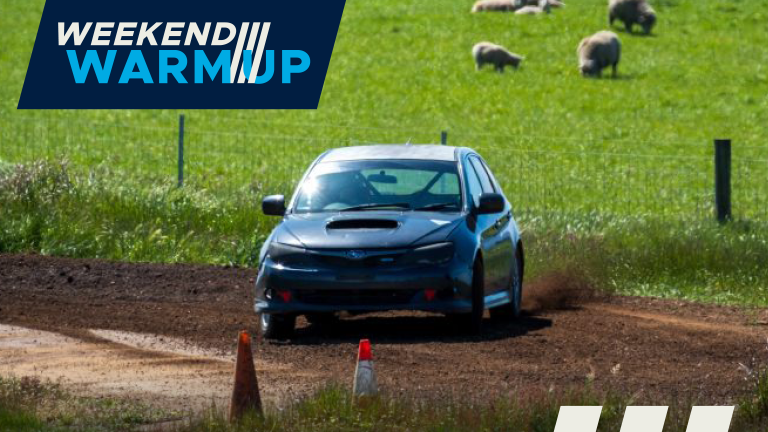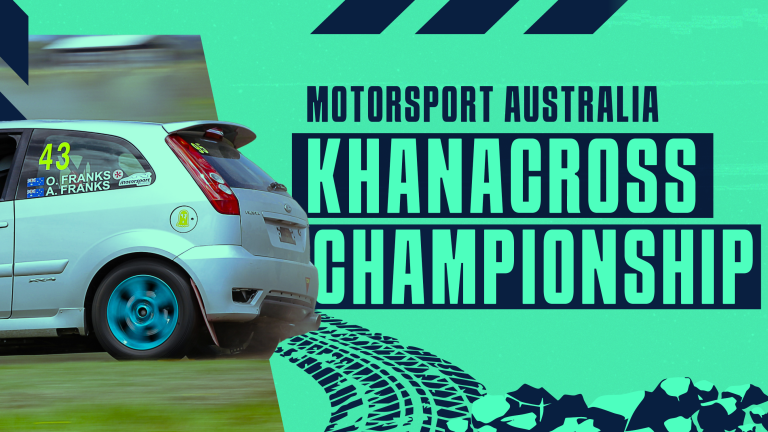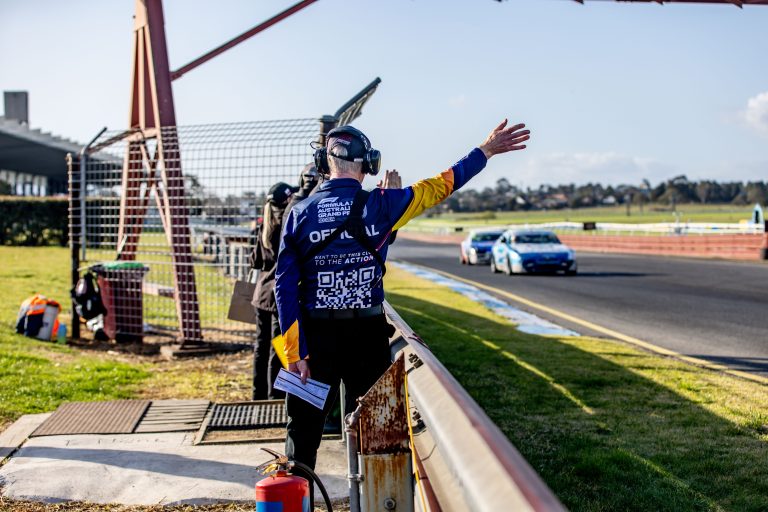The FIA has released further information regarding the installation and operation of plumbed-in fire extinguisher systems in closed cockpit vehicles.
Motorsport Australia recommends members check the Motorsport Australia Manual (Technical Appendix – Schedule H) for the applicable fire extinguisher requirements for Motorsport Australia Competitions.
Specific requirements for electronic boxes approved with 8865-2015 and 8876-2022 extinguisher systems:
Both standards define design requirements for the control boxes for electronically activated systems so their function can be easily understood, no matter the manufacturer. All the boxes must have a switch with two positions (“ARM” and “TEST”) and two LEDs (one orange and one red). Below is a summary of the LED functions.
With the switch in the “TEST” position, the orange LED should illuminate for 5 seconds or more to indicate the system is fully functional. With the switch in this position, any other combination of LED’s indicates there is a problem with the system and it may not function.
With the switch in the “ARM” position, the red LED should flash continuously to indicate the system working and is ready for activation in event of a fire. With the switch in this position, any other combination of LED’s indicates there is a problem with the system and it may not function.
Whilst the FIA Standard includes these design requirements, it remains imperative for all competitors to read the manufacturers’ instructions provided wi th all systems.
Arm the plumbed-in fire extinguisher system or remove safety pin from the mechanically activated plumbed-in fire extinguisher system:
Before taking part in an on-track session or stage, competitors must:
Arm the plumbed-in fire extinguisher system as described above if the system is of an electrical activation type.
Remove the fire extinguisher safety pin from the mechanically activated plumbed-in fire extinguisher system.

System armed – ready to be used (Red LED should flash continuously)

System with safety pin – not ready to be used
Specific requirements for FIA-approved 8865-2015 extinguisher systems:
In order to ensure that the FIA-approved systems are efficient, the FIA regulates type and size of extinguisher to be used based upon both the cockpit volume and compatibility of the extinguishing medium with the fuel used in the vehicle in which the system will be installed.
Cockpit Volume
It is important that the extinguisher model selected is appropriate for the vehicle cockpit volume. If the competitor installs a system that is too small for their vehicle cockpit volume, the system will be less efficient, because the extinguishing medium concentration will be below the required concentration threshold. If the competitor installs a system too big for his vehicle cockpit volume, the system will be efficient, because the extinguishing medium concentration will be well above the minimum defined threshold, but the concentration of extinguishing medium may be too high and may cause the crew to have breathing difficulties.
Several systems are listed with different minimum and maximum cockpit volumes, and the way they operate will be adapted to the volume. The cockpit volume information found in Technical List n°52 is there to protect the driver from a toxic environment while ensuring the system is efficient.
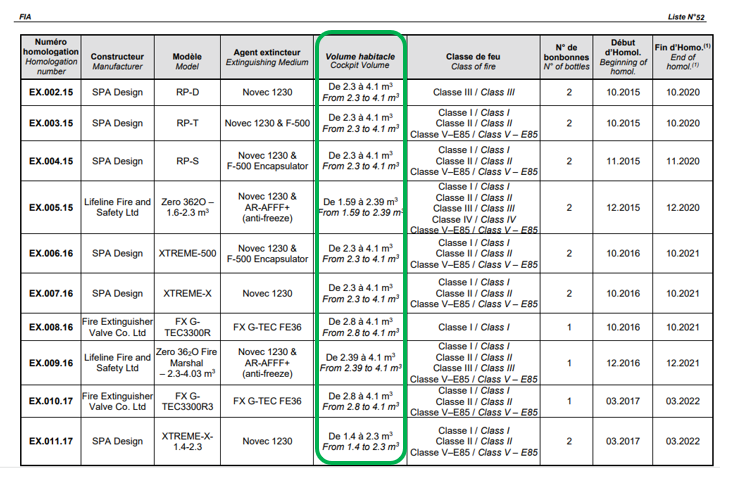
Technical list n°52 and cockpit volumes
Fuel Type or “Class” of Fire:
The type of fuel can greatly influence the behaviour of the fire. All plumbed-in systems (8865-2015 and 8876-2022) are approved for one or more “classes” of fire based upon fuel types, and the technical regulations of each championship will determine for which “class” of fuel the system can be used. The system is tested for each specific class it is approved for, to ensure its efficiency against that type of fire.
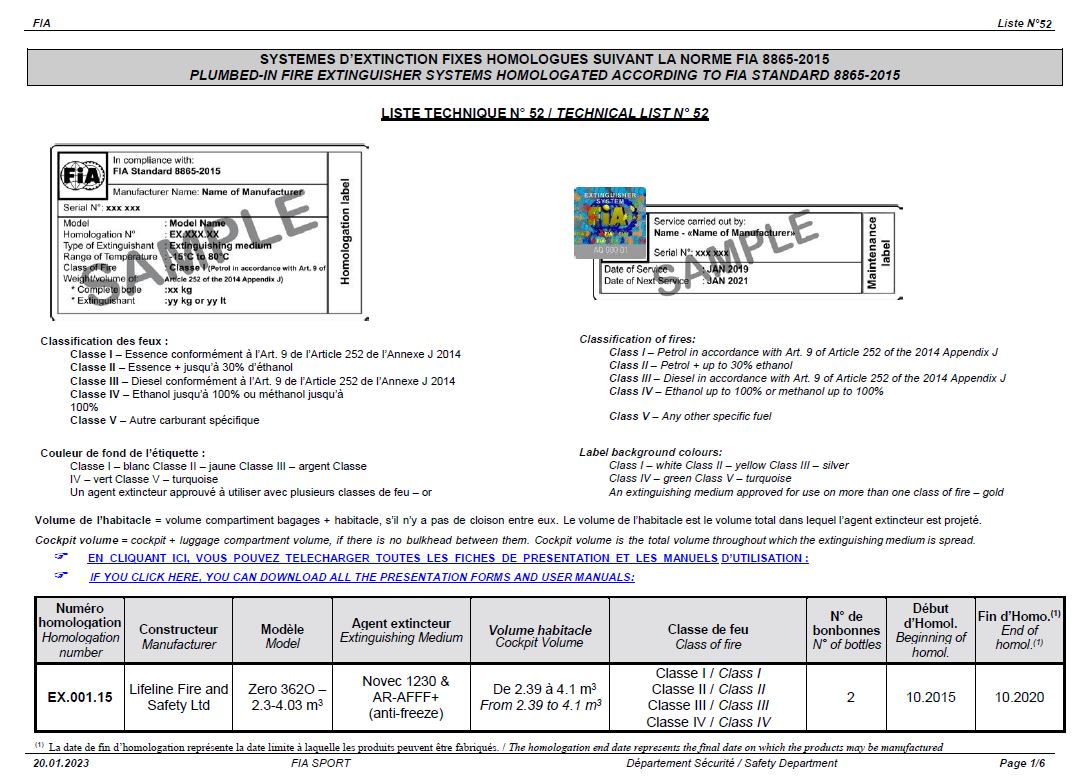
Service & homologation dates:
The FIA label on an extinguishers system displays the “Service Date” i.e., the date before which the system must be checked and serviced by a manufacturer approved service agent.
The “Homologation End Date” contained in FIA Technical List #52 and #16 only relates to the ability of a manufacturer to produce new products under this homologation.
For the avoidance of doubt, if a specific extinguisher was produced before the “Homologation End Date” and its “Service Date” has not yet passed, it can still be used.
Extinguisher manufacturers decide how many times during its life an extinguisher can be serviced, and will refuse to service extinguishers with damage, corrosion or which are deemed no longer safe to use for any other reason.
Key Points
Always Be Ready

Arm the control box as you buckle up.
Remove the pin of the mechanical or hand-held system before leaving the garage.

Familiarise yourself with the system and the triggering protocol.

Activate the plumbed-in and/or hand-held fire extinguisher system at an early stage of the fire to increase effectiveness.

Stop the car and activate the extinguisher immediately when there is a fire.
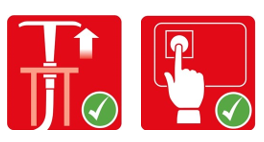
For Hand-held extinguishers:
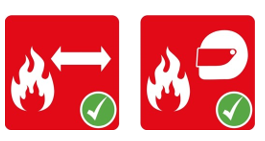
Use any hand-held extinguisher as soon as possible.
Keep a safe distance.
Protect yourself from the fire, heat and smoke.

The first activation is the most efficient,
empty the bottle completely.

Commonly hand-held extinguishers are most efficient upon the first
activation.
The extinguisher is less efficient during the second
discharge due to pressure loss inside the bottle.

80eaf84f98c04ce7bbccdd82022b39e29330eb1de27a4aa38b81ff4f88011dec.jpeg)

